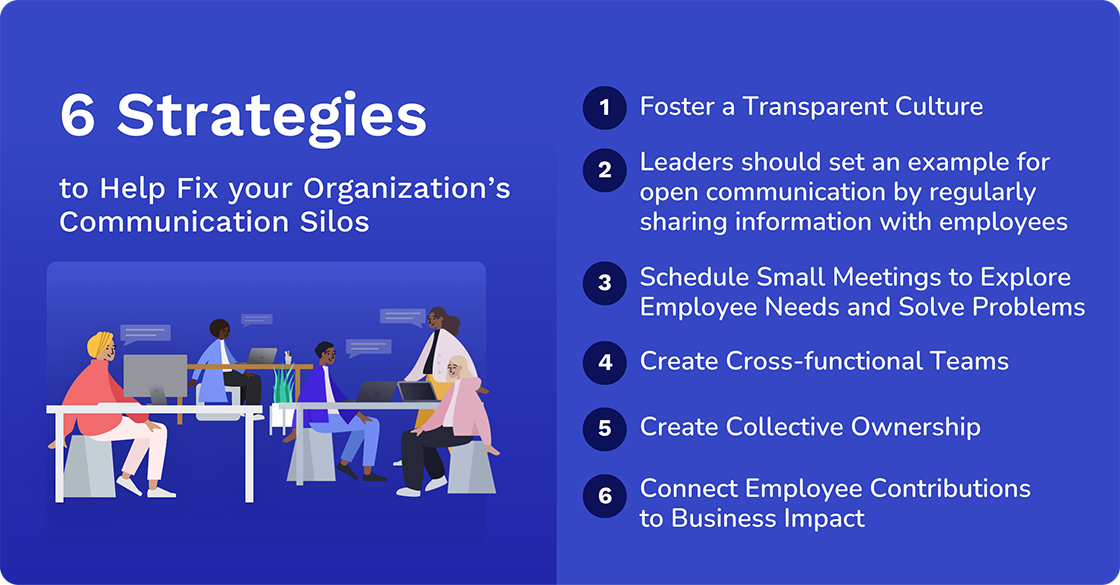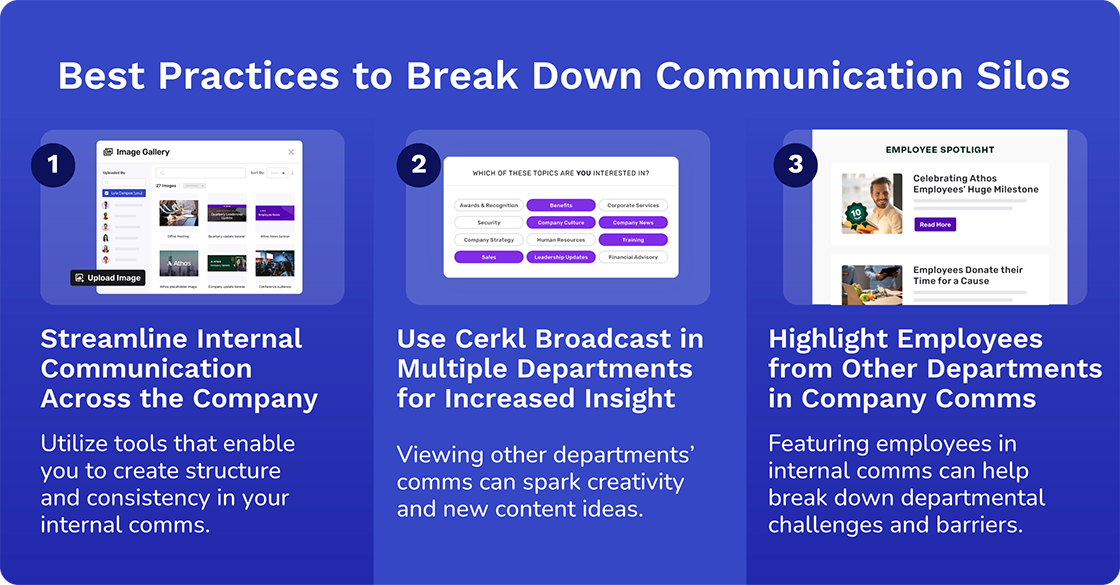Silos pop up in organizations big and small and can be a major drain on employee engagement and productivity. Fight back with these tips.


Effective internal communication is the backbone of every successful organization. Learn the ins and outs of internal communications with our research-backed white paper.
Access NowHave you ever felt as if your communications team is working in a vacuum, unaware of what other departments are up to? Or maybe you've sent an email that seemed to vanish into the digital ether, never reaching its intended recipient. These are classic signs of communication silos — isolated pockets within an organization where information gets trapped.
What commonly happens is that different departments, teams, or individuals within an organization fail to share information, coordinate efforts, or collaborate effectively. This can lead to all kinds of problems from misunderstandings and poor decision-making to decreased employee engagement, all of which can impact negatively on customer experience and the reputation of the company.
Mercer’s Global Talent Trends 2024 identifies the top five challenges facing the human resources (HR) function. One of these relates to coordination between HR functional silos, centers of excellence (COEs), and human resources business partners, with close to a third (32%) of respondents identifying it as their top challenge.
In this post, we're going to discuss what communication silos are and how they can impact negatively on an organization's success. We will also explore actionable steps that you can take to dismantle the barriers that lead to communication silos so you can communicate effectively and foster a culture of open communication.
Now’s your chance to ditch the confusion and get ready to build a more collaborative and informed workplace!
Turn your internal communications strategy around today

Imagine a tall, cylindrical structure used to store grain on a farm. This is an agricultural silo.
While the original term relates to the agricultural practice of storing grain in separate silos, today the term silo also refers to internal communication. In corporate settings, communication silos refer to isolated groups or departments that only communicate within themselves, neglecting to consider the broader objectives of the organization.
Communication silos operate with limited visibility in the bigger picture, typically hampering collaboration and overall efficiency. The phrase "break down silos" is a common idiom that means to eliminate or reduce the barriers or obstacles that prevent different departments, teams, or individuals from communicating and collaborating effectively. It promotes an open, collaborative culture where employees from different departments can share knowledge, ideas, and resources to achieve common goals.

Numerous factors can contribute to the formation of communication silos. By recognizing how they form, organizations can take proactive steps to prevent or dismantle communication silos, fostering a more collaborative and cohesive work environment.
Traditional, top-down organizational structures can create barriers between departments, making it difficult for information to flow freely and encouraging siloed thinking.
When organizations are highly departmentalized, teams can become focused on their own goals and priorities. This results in them being less likely to communicate with colleagues in other departments. Instead, different departments tend to focus solely on their specific tasks and goals, rather than considering the broader organizational objectives. Typically, this leads to a lack of awareness of what other teams are working on, which makes it difficult to collaborate on projects.
Additionally, when teams don't regularly interact or work together on projects, they may become disconnected from the organization's overall goals and objectives.
Poor communication practices like unclear channels and information hoarding, create a breeding ground for silos. When employees feel unsure where to share information or fear blame, they retreat into isolated teams. Ultimately, poor communication, inadequate feedback, and unclear expectations can lead to misunderstandings, mistrust, and eventually, the formation of silos.
A leadership style that emphasizes individual achievement over collaboration can also perpetuate siloed thinking within an organization.
Different communication tools and platforms can create silos if they make it difficult for employees to share information with each other. For example, if one team uses a different project management system than another team, it can be difficult for them to collaborate on projects.
Additionally, when teams don't regularly interact or work together on projects, they may become disconnected from the organization's overall goals and objectives.
Diverse teams with different cultural backgrounds, languages, or jargon can create communication barriers, contributing to the formation of silos.
Remote teams or offices can lead to a sense of disconnection, making it challenging to collaborate and share information across departments.
Performance metrics and reward systems that focus on individual or departmental achievements rather than organizational goals can encourage siloed behavior.

Here are a couple of typical real-life scenarios that illustrate how communication silos can, potentially, play out. Remember that communication silos can manifest in many ways. But the underlying problem remains. Information isn't flowing freely, obstructing collaboration and creating roadblocks to success.
The marketing team develops a captivating campaign to launch a new product line. However, they neglect to loop in the sales team that is left scrambling to understand the product's features and benefits when leads start pouring in. This lack of communication can lead to frustrated customers and missed sales opportunities.
A company implements a new company policy, but the communication only goes out to management. Frontline employees are left in the dark about the changes, leading to confusion, frustration, and potential resistance to the new policy.
Communication silos can have many negative consequences for organizations. Resulting primarily from poor communication, consequences include a reduction in productivity, poor decision-making, and a disturbing decrease in the morale of employees.
Grammarly’s 2024 State of Business Communication, developed in partnership with The Harris Poll provides statistics. Poor communication leads to:
Effective communication, on the other hand, leads to:
When employees don't have access to the information they need, it can take them longer to complete tasks. Silos can also lead to duplication of effort, as teams may be working on the same problem without knowing it.
If decision-makers don't have access to all the relevant information, they are more likely to make poor decisions. Silos can also lead to a lack of buy-in from employees, as they may not feel like they have been heard.
When employees feel isolated and out of the loop, this can lead to decreased morale and motivation. Silos can also make it difficult to build trust and rapport between colleagues.
Turn your internal communications strategy around today

Fortunately, there are proven ways that organizations can act to break down communication silos and improve information sharing. For instance, you can Invest in communication tools and training, providing employees with what they need to communicate effectively. This includes things like communication platforms, project management systems, and training on active listening and giving feedback.
By taking steps to break down communication silos, organizations can create a more collaborative and productive work environment. They can encourage employees to share information by rewarding those who collaborate with others. This could include public recognition or bonuses.
An article published by Forbes, 13 Strategies For Breaking Down Silos And Boosting Interdepartmental Communication, provides a wealth of ideas. These also draw on real experiences from business owners and leaders. We dipped into a few of them.
It’s not enough to communicate simply for the sake of communication. You need to make sure that everyone feels like they are on your team so that they routinely share information. This is the best way to get ahead of challenges before they surface.
Leaders need to set the tone for open communication by being transparent themselves. This means sharing information with employees regularly, even when it's bad news. Jason Murray, a co-founder of Fringe, a personalized benefits marketplace designed to empower employees, aims to help create environments that allow people to thrive.
“The example that leaders set is one of the most critical aspects of breaking down silos. Ensure that team leads are regularly meeting and communicating with one another to foster alignment around goals and identify issues before they arise.”
Jason Murray
It’s essential to establish clear lines of communication between departments. But rather than setting up large meetings where people end up debating irrelevant issues, you can often solve problems by setting up smaller meetings. These may even involve only two or three people who actually know what the problem is.
Bringing together employees from different departments to work on projects can help to break down silos and improve communication. Cross-functional teams can also help to identify and solve problems that would be difficult for any one department to tackle on its own. This is an approach that Alexander Westgarth Founder and CEO of WineCap Ltd promotes.
“To ensure different departments communicate clearly, managers can form cross-functional teams composed of employees from different departments to work together towards common goals. This approach can break down silos, improve collaboration, enhance understanding of roles and lead to more effective problem-solving.”
Alexander Westgarth
Leaders need to strategize and enable collective ownership of their strategies. This is the best way to unite departments and enable them to collaborate.
René Janssen, Founder and CEO of Lepaya, a learning and development training provider, encourages managers to break down silos. He says they can do this by connecting individual career paths to overall business impact.
“It helps employees see beyond their scope and build knowledge sharing into the DNA of the organization. Such an approach breaks silos down because the only way to ‘move the needle’ is to give people the right skills at the right time to collaborate on the right projects that are tied to overall business success.”
René Janssen

The Cerkl Broadcast Customer Success (CS) team highlights the best practices for breaking down communication silos and minimizing the silo mentality. These include streamlining communication, increasing insight across multiple departments, and highlighting employee activities and achievements throughout the company.
Many, if not most, companies are structured with different departments that have their own leadership and ways of doing things. This often leads to a lack of oversight, structure, and consistency in terms of the overall communications within the company. Unfortunately, this can be very disruptive, which is why it’s so important to streamline internal communication across the company and promote cohesion. Cerkl Broadcast makes this possible.
Some of the Broadcast features you can use to help streamline communication include:
The Image Gallery can be used as a valuable repository of images that everyone in the organization has access to. It can be particularly useful for cross-functional communication where employees or teams from different departments share ideas, information, and feedback.
Streamlining communication might include the ability of all team members from different departments to read, duplicate, edit, and resend Email Blasts. However, it often makes sense to limit or restrict segments that only admins and certain team members have access to. There’s no golden rule. The beauty of the system is that you can adapt it to meet your needs by segmenting access permissions.
Using Sender Proxies or Sender Profiles allows teams to enable certain people to send Email Blasts on behalf of another person. It is also possible to set up permissions so that all team members can do this. This increases efficiency and productivity, streamlining the communications process. It also helps to reduce bottlenecks. Nothing is set in stone, and you can add or remove sender permissions when necessary.
A great way to streamline communications is to use Email Blast templates. If you’ve sent a Blast that works really well, you can save it as a template for future use. Alternatively, you can create one from scratch. Using Email Blast templates saves time and effort because you already have the design and format you want. Templates also give you the opportunity to use consistent formatting, typography, and imagery, which helps to reinforce the image of your brand.
Most organizations have their own important days. Typically, these include campaign launches, communication blackout days, and so on. The Broadcast Important Days feature allows you to skip News Digests on the days you indicate, which is an important element of streamlining comms.
When multiple departments use Broadcast, they get to see the type of communications other departments are sending out. It's an added benefit from a creativity standpoint because communicators are no longer only exposed to content being sent from their individual departments.
For example, an internal communicator from HR might notice some really engaging content or stories that the folks in the Customer Support department have been sending out lately. Broadcast is the catalyst that leads HR to have a strategic conversation with Customer Support, so they can pick their brain and possibly implement some of Customer Support’s ideas into their own communications.
Broadcast News Digest makes it possible to categorize different stories so people can select those they are interested in. Communicators can also deliberately prioritize that content to put people in the spotlight of company communications. And if departments are working in different instances within Broadcast, they can easily share certain types of stories across these instances.
Company communicators can achieve a lot by highlighting employees from different departments in their messages. This helps to create a culture where employees are excited to learn about people in other departments. They are also more likely to see people as people, rather than people in other departments, and there is more of a culture-value connection.
In the Cerkl CS team’s experience, some of the most popular stories employees respond to relate to human interest and posts that celebrate teams who are impacting continuous improvement or making important advancements for the company.
Highlighting people across the company can help to break down departmental challenges and barriers, especially between internal communications and various other groups. People reading these communications feel seen, and they feel like they are part of the bigger group in a more cohesive way. It is a proven strategy of writing about your people and making everyone feel like they are a part of one bigger team. It’s also about finding very human ways to eliminate barriers.
One example they cite is an HR software company that includes an employee spotlight in its Internal communications every week. The same company has created a form and an internal system for any employee to submit items for inclusion in their news digest. This might be a story, a highlight, a call for participation (eg a need for volunteers), or anything else that might be relevant.
Another example is a non-profit organization in the healthcare industry that features “an employee dog of the week.” Now that’s fun, isn’t it?

Cerkl Broadcast is an internal communication platform that can help organizations improve cross-functional communication and collaboration. With Cerkl Broadcast, you can:
If you're looking for a way to improve communication and avoid a silo mentality in your workplace, Cerkl Broadcast can help.
Are you aware of communication silos in your organization? If so, do you know the causes? Either way, an excellent approach is to audit your communication strategy and channels to identify and understand possible sources. Once you have identified causes, you can take steps to break the silos down, and start to communicate effectively throughout the organization.

Turn your internal communications strategy around today

Turn your internal communications strategy around today